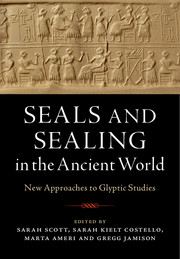 Seals and Sealing in the Ancient World
Seals and Sealing in the Ancient World Book contents
- Seals and Sealing in the Ancient World
- Seals and Sealing in the Ancient World
- Copyright page
- Contents
- Notes on Contributors
- Illustrations
- Plates
- Tables
- Acknowledgments
- Preface
- Abbreviations
- Chapter One Introduction: Small Windows, Wide Views
- Part I The Ancient Near East and Cyprus
- Part II South Asia and the Gulf Region
- Chapter Eight Indus Seals and Glyptic Studies: An Overview
- Chapter Nine Letting the Pictures Speak: An Image-Based Approach to the Mythological and Narrative Imagery of the Harappan World
- Chapter Ten Understanding Indus Seal-Carving Traditions: A Stylistic and Metric Approach
- Chapter Eleven Operational Sequences and Stamp Seals: A Preliminary Report on an Experimental and Microtopographic Framework for Identifying Groups of Seal Carvers in the Indus Civilization
- Chapter Twelve Seals and Sealing Technology in the Dilmun Culture: The Post-Harappan Life of the Indus Valley Sealing Tradition
- Part III Egypt
- Part IV Aegean
- References
- Endnotes
- Index
Chapter Ten - Understanding Indus Seal-Carving Traditions: A Stylistic and Metric Approach
from Part II - South Asia and the Gulf Region
Published online by Cambridge University Press: 24 April 2018
- Seals and Sealing in the Ancient World
- Seals and Sealing in the Ancient World
- Copyright page
- Contents
- Notes on Contributors
- Illustrations
- Plates
- Tables
- Acknowledgments
- Preface
- Abbreviations
- Chapter One Introduction: Small Windows, Wide Views
- Part I The Ancient Near East and Cyprus
- Part II South Asia and the Gulf Region
- Chapter Eight Indus Seals and Glyptic Studies: An Overview
- Chapter Nine Letting the Pictures Speak: An Image-Based Approach to the Mythological and Narrative Imagery of the Harappan World
- Chapter Ten Understanding Indus Seal-Carving Traditions: A Stylistic and Metric Approach
- Chapter Eleven Operational Sequences and Stamp Seals: A Preliminary Report on an Experimental and Microtopographic Framework for Identifying Groups of Seal Carvers in the Indus Civilization
- Chapter Twelve Seals and Sealing Technology in the Dilmun Culture: The Post-Harappan Life of the Indus Valley Sealing Tradition
- Part III Egypt
- Part IV Aegean
- References
- Endnotes
- Index
Summary
Inscribed steatite seals are among the most important components of Indus material assemblages. During the Integration Era of the Harappa phase (2600–1900 BCE) these objects were used to serve a variety of purposes, yet many important questions remain regarding how and where they were made, and how production would have varied within and among different settlements. This study presents a novel method for analyzing the organization of Indus seal production. By combining formal stylistic and metric analyses of various elements of inscribed steatite seals, it is possible to fingerprint groups of seals that would have been carved by different producers working throughout the Indus region. Preliminary results suggest that these techniques are useful for providing new insights into the scale and nature of variation in Indus seal-carving traditions. The methods applied in this study can be employed to analyze seals from other world regions to provide new insights into how production was organized and varied in time and space.
- Type
- Chapter
- Information
- Seals and Sealing in the Ancient WorldCase Studies from the Near East, Egypt, the Aegean, and South Asia, pp. 167 - 186Publisher: Cambridge University PressPrint publication year: 2018
